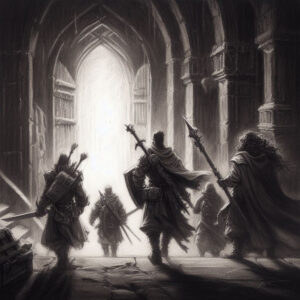
The year 1984 marked a significant chapter in the saga of role-playing games with the release of the Dungeons & Dragons Companion Rules box set. This pivotal edition formed the third tier of the famed BECMI system (Basic, Expert, Companion, Master, Immortal), a sequence designed to guide players through an increasingly complex and rewarding fantasy world. Under the guidance of Frank Mentzer, the D&D series not only consolidated previous rules but also expanded into new territories that captured the imaginations of players worldwide.
The Companion Rules set was not just another rulebook; it was a gateway to high adventure, allowing characters to advance from the 15th to the 25th level. This progression was not merely about gaining more power but also about the responsibilities and grand scale of activities that high-level characters would undertake, such as ruling dominions, leading armies, and even becoming involved in the politics of the game world's empires.
One of the most intriguing aspects of the Companion Rules was its introduction of the concept of dominion management. Players could now become rulers of their territories, engaging in the intricacies of governance, from the economics of land and resource management to the challenges of leadership and defense against usurpers. This addition was not just a layer of complexity but a transformation of the game into a simulation of rulership, merging strategy with traditional role-playing elements.
The box set also enriched the game's mechanics by introducing new classes and feats, specifically tailored for these higher levels. This allowed for more detailed character development and specialization, which, when combined with the challenges of dominion management and warfare, provided a deeply immersive experience. The rules for large-scale battles brought an epic dimension to campaigns, enabling players to command legions in sieges and field battles, adding a tactical depth previously unseen in the series.
Trivia enthusiasts would delight in knowing that the art for the Companion Rules set was created by the acclaimed artist Larry Elmore, whose work would become synonymous with the face of Dungeons & Dragons during that era. His iconic cover illustrations helped define the visual aesthetics of the game and played a crucial role in attracting a broader audience.
The Companion Rules set was part of a broader strategy to create a comprehensive and cohesive rule system that could take a player from novice to demi-god through the different box sets. This was a unique approach at the time, as it offered a structured path of progression that was both accessible to beginners and deeply engaging for seasoned players.
The Companion Rules also served as a bridge to the subsequent Master and Immortal sets, which would take characters to even greater heights of power and into the realms of the gods themselves. This continuity not only kept players invested in the long term but also fostered a sense of progression and achievement that was rewarding both in gameplay and narrative development.
In the broader context of role-playing history, the Companion Rules exemplify a period of intense creativity and expansion within the industry. This box set, along with its siblings in the BECMI line, helped solidify Dungeons & Dragons' place at the heart of the gaming world and influenced a generation of games and gamers alike.
The Dungeons & Dragons Companion Rules box set remains a cherished artifact in the RPG community. Its legacy is not just in the richness of gameplay it introduced but in how it expanded the boundaries of what a role-playing game could be, weaving intricate narratives with elaborate rule systems to create something truly magical. For many, it represents not just a set of rules but a doorway to a lifetime of adventure.
The Dungeons & Dragons Companion Rules box set is more than just a collection of expanded rules for gaming; it's a treasure trove of intriguing trivia and fascinating historical nuggets. Released in 1984, this edition not only pushed the boundaries of high-level gameplay but also left a lasting impact on the culture and evolution of role-playing games. Let's dive into the captivating trivia surrounding this iconic set.
The Genesis of High Adventure
The Companion Rules were part of the BECMI system, meticulously designed to guide players from novice adventurers to demi-gods. Each level of the system introduced not just new powers but also new responsibilities, with the Companion set focusing on the transition from mere adventurers to rulers and commanders. This shift wasn't just a gameplay evolution-it was a narrative deepening, enriching the player's journey with every roll of the dice.
Artistic Vision
The artwork of Larry Elmore graced the cover of the Companion Rules, his illustrations becoming synonymous with the look and feel of Dungeons & Dragons during the 1980s. Elmore's ability to capture the essence of adventure and fantasy helped define the visual identity of D&D and attracted a wider audience to the world of role-playing. His depiction of dynamic characters and vibrant scenes was not just promotional; it was inspirational, drawing players into the game before they even opened the box.
A Design Philosophy
Frank Mentzer, the architect behind the BECMI system, envisioned a cohesive and comprehensive gaming experience that would be accessible to beginners yet sufficiently complex for veterans. This philosophy extended beyond mere rule-making; it was about crafting a narrative framework that could support years of gaming. The Companion Rules set, in particular, emphasized this by introducing scenarios that required not just tactical thinking but also strategic governance, a novelty at the time.
Impact on Future Editions
The innovations introduced in the Companion Rules would resonate through later editions of Dungeons & Dragons. Concepts like dominion management and large-scale warfare became staples in the series, influencing both game mechanics and the storytelling potential of later modules. The set's emphasis on leadership and empire-building prefigured modern role-playing games that blend strategy and personal narrative.
Cultural Influence
Beyond its immediate impact on gaming, the Companion Rules box set also played a part in shaping the broader fantasy culture. It arrived during a surge of interest in fantasy literature, movies, and art, contributing to a burgeoning fandom eager for complex, immersive experiences. The set's release not only capitalized on this trend but helped propel the fantasy genre into mainstream entertainment, paving the way for future blockbuster films, books, and games.
A Legacy of Creativity
The Dungeons & Dragons Companion Rules box set is remembered not just for its content but for its role in fostering creativity and imagination. It encouraged players to think beyond individual battles and adventures, contemplating larger ethical and managerial dilemmas. This expansion of scope was a critical step in the evolution of role-playing into a form of interactive storytelling that could explore complex themes and personal growth.
The Dungeons & Dragons Companion Rules box set is a cornerstone of RPG history. Its release marked a significant evolution in the way games could structure and encourage narrative depth. Each trivia piece connected to this set not only highlights its unique contributions to gaming but also encapsulates a moment in cultural history when gaming was on the cusp of becoming a major force in entertainment and storytelling.






